In-depth Study: Evaluating Public Transport Benefits and Future
VerifiedAdded on 2023/05/26
|9
|2082
|399
Report
AI Summary
This report provides a comprehensive analysis of the benefits of public transportation, highlighting its social, health, and economic advantages. It discusses how public transport promotes physical activity, reduces environmental pollution, and alleviates stress associated with private vehicle ownership. The report also emphasizes the social unity fostered by shared commuting experiences and the enhanced safety and freedom of movement offered by public transport systems. Furthermore, it addresses the cost-saving aspects of public transport compared to private vehicle ownership, considering factors like fuel costs, insurance, and parking fees. The report concludes with recommendations for improving public transport, such as enhancing comfort, optimizing online ticketing systems, and expanding connectivity to remote areas, ultimately aiming to increase user satisfaction and promote a greater shift towards public transport.
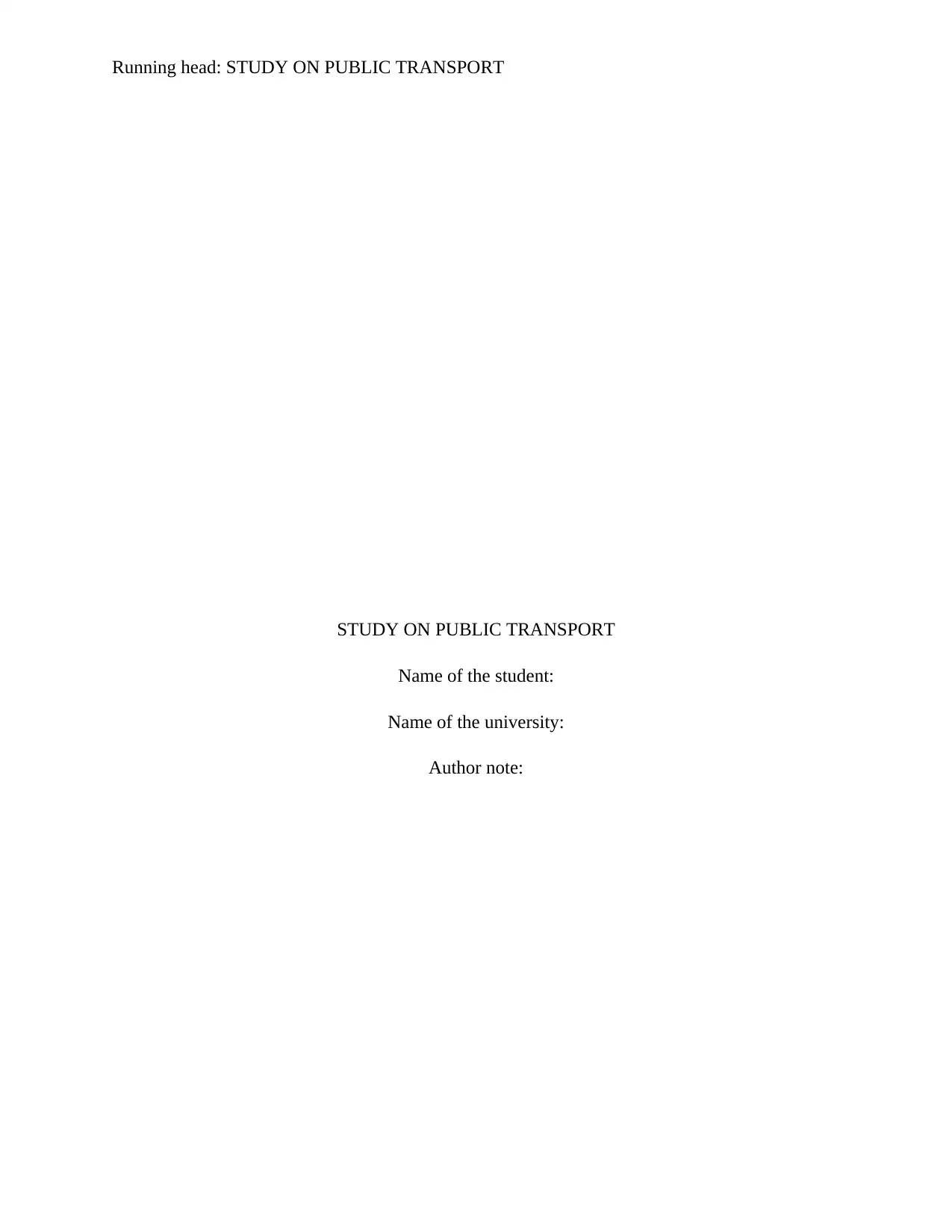
Running head: STUDY ON PUBLIC TRANSPORT
STUDY ON PUBLIC TRANSPORT
Name of the student:
Name of the university:
Author note:
STUDY ON PUBLIC TRANSPORT
Name of the student:
Name of the university:
Author note:
Paraphrase This Document
Need a fresh take? Get an instant paraphrase of this document with our AI Paraphraser
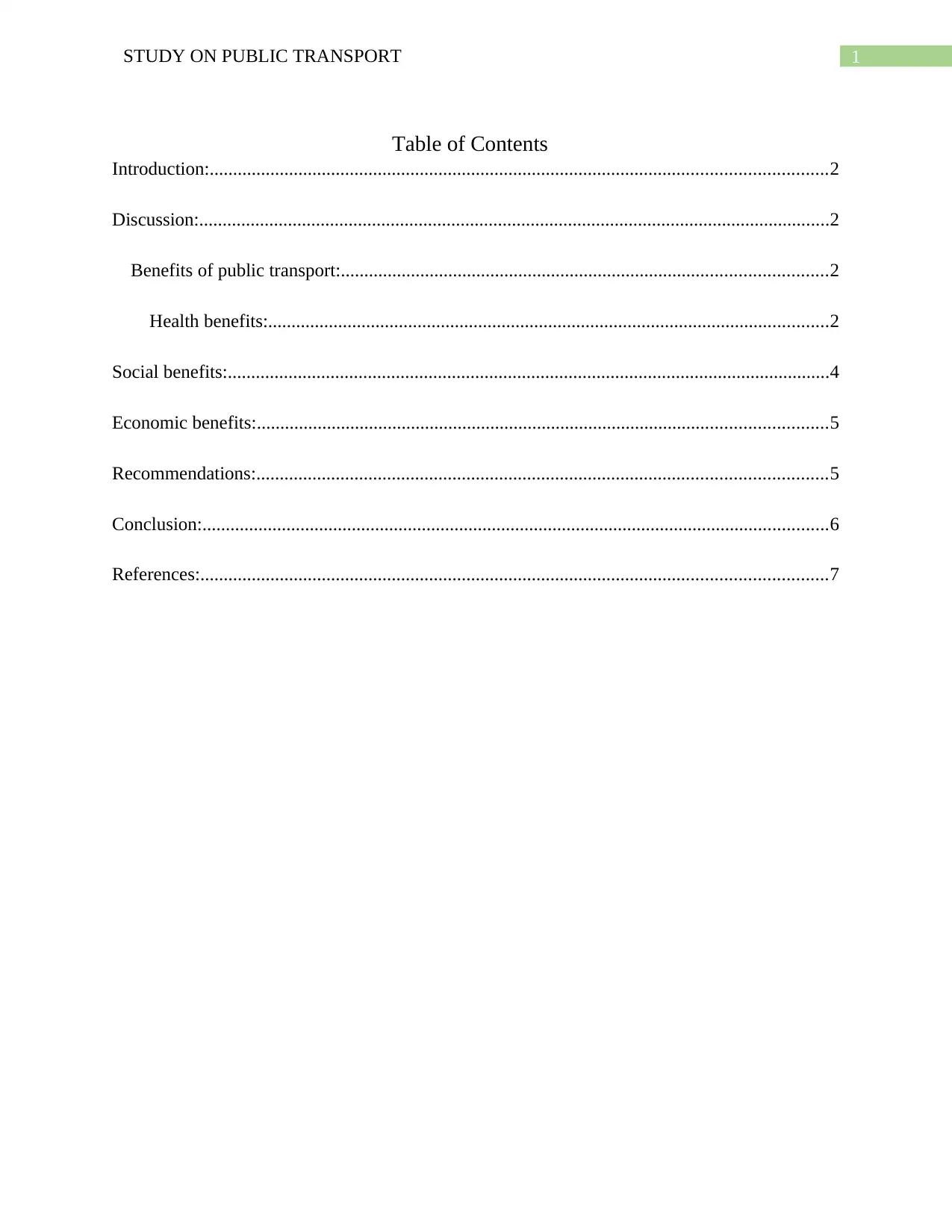
1STUDY ON PUBLIC TRANSPORT
Table of Contents
Introduction:....................................................................................................................................2
Discussion:.......................................................................................................................................2
Benefits of public transport:........................................................................................................2
Health benefits:........................................................................................................................2
Social benefits:.................................................................................................................................4
Economic benefits:..........................................................................................................................5
Recommendations:..........................................................................................................................5
Conclusion:......................................................................................................................................6
References:......................................................................................................................................7
Table of Contents
Introduction:....................................................................................................................................2
Discussion:.......................................................................................................................................2
Benefits of public transport:........................................................................................................2
Health benefits:........................................................................................................................2
Social benefits:.................................................................................................................................4
Economic benefits:..........................................................................................................................5
Recommendations:..........................................................................................................................5
Conclusion:......................................................................................................................................6
References:......................................................................................................................................7
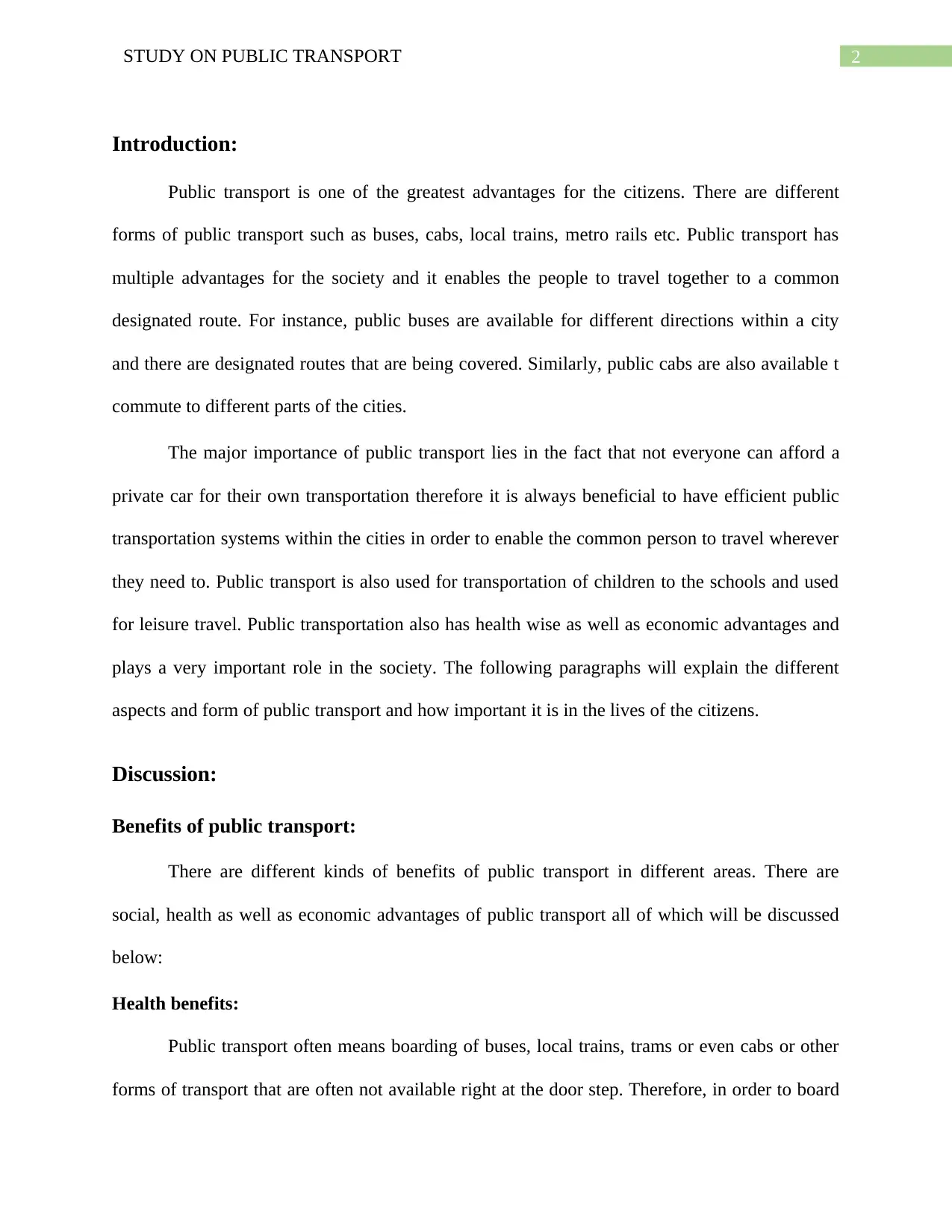
2STUDY ON PUBLIC TRANSPORT
Introduction:
Public transport is one of the greatest advantages for the citizens. There are different
forms of public transport such as buses, cabs, local trains, metro rails etc. Public transport has
multiple advantages for the society and it enables the people to travel together to a common
designated route. For instance, public buses are available for different directions within a city
and there are designated routes that are being covered. Similarly, public cabs are also available t
commute to different parts of the cities.
The major importance of public transport lies in the fact that not everyone can afford a
private car for their own transportation therefore it is always beneficial to have efficient public
transportation systems within the cities in order to enable the common person to travel wherever
they need to. Public transport is also used for transportation of children to the schools and used
for leisure travel. Public transportation also has health wise as well as economic advantages and
plays a very important role in the society. The following paragraphs will explain the different
aspects and form of public transport and how important it is in the lives of the citizens.
Discussion:
Benefits of public transport:
There are different kinds of benefits of public transport in different areas. There are
social, health as well as economic advantages of public transport all of which will be discussed
below:
Health benefits:
Public transport often means boarding of buses, local trains, trams or even cabs or other
forms of transport that are often not available right at the door step. Therefore, in order to board
Introduction:
Public transport is one of the greatest advantages for the citizens. There are different
forms of public transport such as buses, cabs, local trains, metro rails etc. Public transport has
multiple advantages for the society and it enables the people to travel together to a common
designated route. For instance, public buses are available for different directions within a city
and there are designated routes that are being covered. Similarly, public cabs are also available t
commute to different parts of the cities.
The major importance of public transport lies in the fact that not everyone can afford a
private car for their own transportation therefore it is always beneficial to have efficient public
transportation systems within the cities in order to enable the common person to travel wherever
they need to. Public transport is also used for transportation of children to the schools and used
for leisure travel. Public transportation also has health wise as well as economic advantages and
plays a very important role in the society. The following paragraphs will explain the different
aspects and form of public transport and how important it is in the lives of the citizens.
Discussion:
Benefits of public transport:
There are different kinds of benefits of public transport in different areas. There are
social, health as well as economic advantages of public transport all of which will be discussed
below:
Health benefits:
Public transport often means boarding of buses, local trains, trams or even cabs or other
forms of transport that are often not available right at the door step. Therefore, in order to board
⊘ This is a preview!⊘
Do you want full access?
Subscribe today to unlock all pages.

Trusted by 1+ million students worldwide
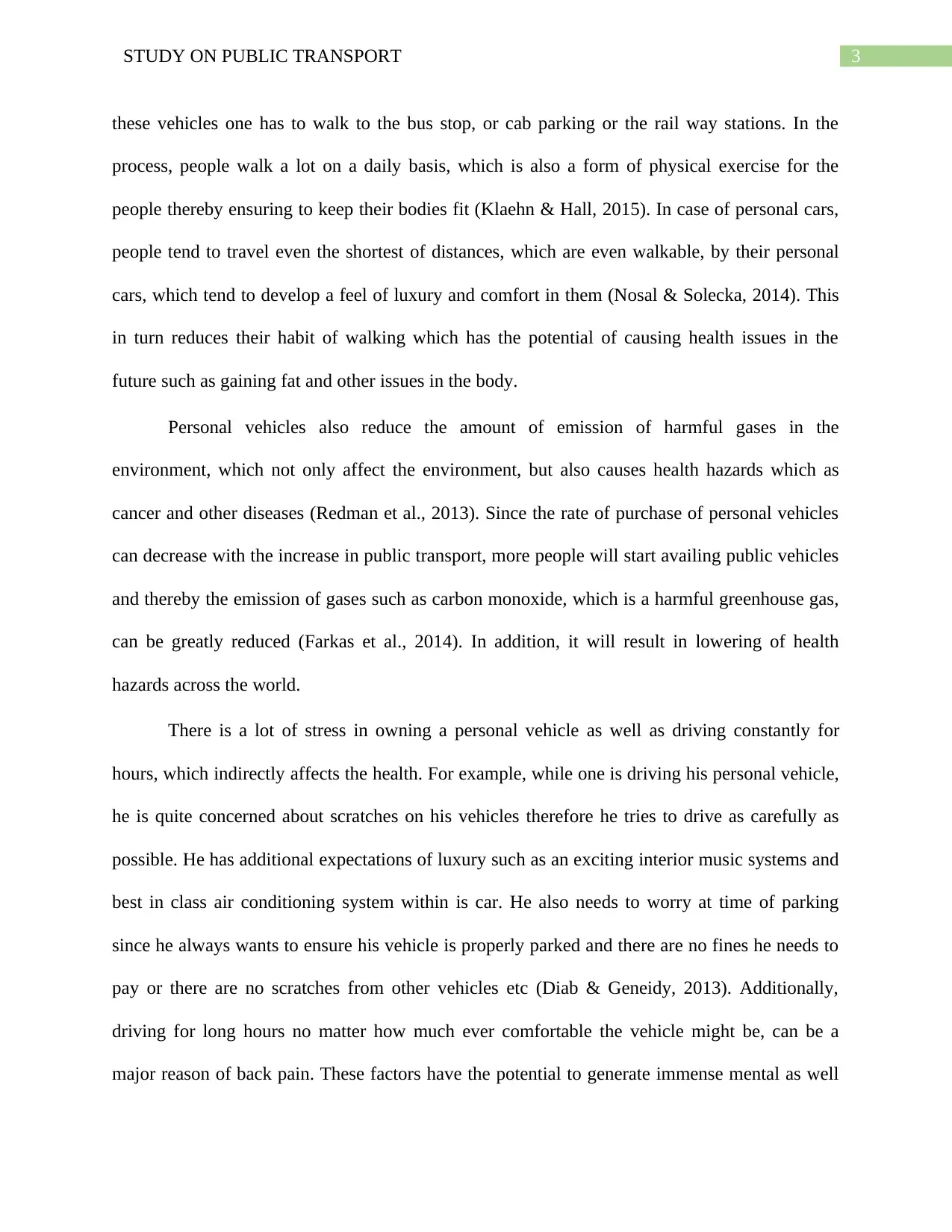
3STUDY ON PUBLIC TRANSPORT
these vehicles one has to walk to the bus stop, or cab parking or the rail way stations. In the
process, people walk a lot on a daily basis, which is also a form of physical exercise for the
people thereby ensuring to keep their bodies fit (Klaehn & Hall, 2015). In case of personal cars,
people tend to travel even the shortest of distances, which are even walkable, by their personal
cars, which tend to develop a feel of luxury and comfort in them (Nosal & Solecka, 2014). This
in turn reduces their habit of walking which has the potential of causing health issues in the
future such as gaining fat and other issues in the body.
Personal vehicles also reduce the amount of emission of harmful gases in the
environment, which not only affect the environment, but also causes health hazards which as
cancer and other diseases (Redman et al., 2013). Since the rate of purchase of personal vehicles
can decrease with the increase in public transport, more people will start availing public vehicles
and thereby the emission of gases such as carbon monoxide, which is a harmful greenhouse gas,
can be greatly reduced (Farkas et al., 2014). In addition, it will result in lowering of health
hazards across the world.
There is a lot of stress in owning a personal vehicle as well as driving constantly for
hours, which indirectly affects the health. For example, while one is driving his personal vehicle,
he is quite concerned about scratches on his vehicles therefore he tries to drive as carefully as
possible. He has additional expectations of luxury such as an exciting interior music systems and
best in class air conditioning system within is car. He also needs to worry at time of parking
since he always wants to ensure his vehicle is properly parked and there are no fines he needs to
pay or there are no scratches from other vehicles etc (Diab & Geneidy, 2013). Additionally,
driving for long hours no matter how much ever comfortable the vehicle might be, can be a
major reason of back pain. These factors have the potential to generate immense mental as well
these vehicles one has to walk to the bus stop, or cab parking or the rail way stations. In the
process, people walk a lot on a daily basis, which is also a form of physical exercise for the
people thereby ensuring to keep their bodies fit (Klaehn & Hall, 2015). In case of personal cars,
people tend to travel even the shortest of distances, which are even walkable, by their personal
cars, which tend to develop a feel of luxury and comfort in them (Nosal & Solecka, 2014). This
in turn reduces their habit of walking which has the potential of causing health issues in the
future such as gaining fat and other issues in the body.
Personal vehicles also reduce the amount of emission of harmful gases in the
environment, which not only affect the environment, but also causes health hazards which as
cancer and other diseases (Redman et al., 2013). Since the rate of purchase of personal vehicles
can decrease with the increase in public transport, more people will start availing public vehicles
and thereby the emission of gases such as carbon monoxide, which is a harmful greenhouse gas,
can be greatly reduced (Farkas et al., 2014). In addition, it will result in lowering of health
hazards across the world.
There is a lot of stress in owning a personal vehicle as well as driving constantly for
hours, which indirectly affects the health. For example, while one is driving his personal vehicle,
he is quite concerned about scratches on his vehicles therefore he tries to drive as carefully as
possible. He has additional expectations of luxury such as an exciting interior music systems and
best in class air conditioning system within is car. He also needs to worry at time of parking
since he always wants to ensure his vehicle is properly parked and there are no fines he needs to
pay or there are no scratches from other vehicles etc (Diab & Geneidy, 2013). Additionally,
driving for long hours no matter how much ever comfortable the vehicle might be, can be a
major reason of back pain. These factors have the potential to generate immense mental as well
Paraphrase This Document
Need a fresh take? Get an instant paraphrase of this document with our AI Paraphraser
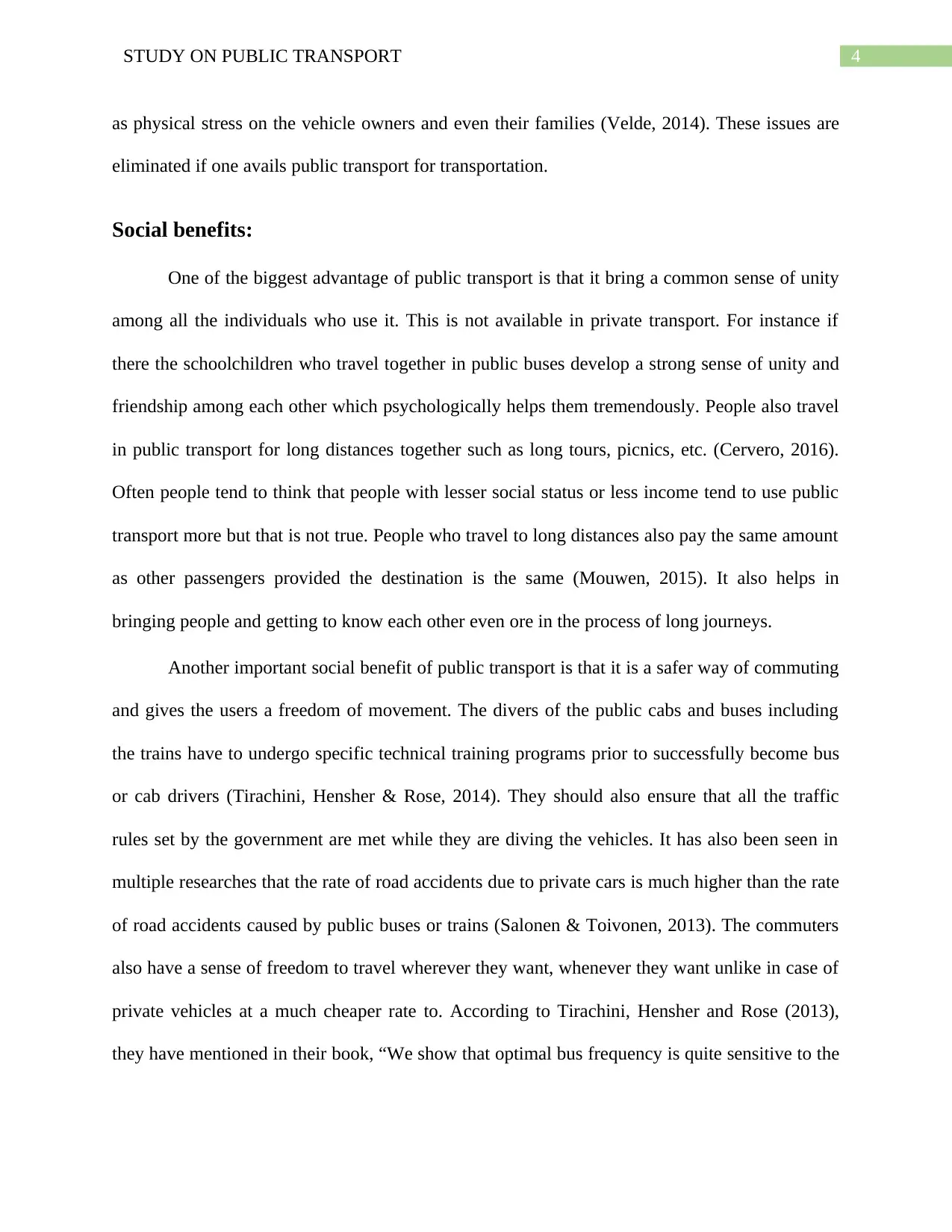
4STUDY ON PUBLIC TRANSPORT
as physical stress on the vehicle owners and even their families (Velde, 2014). These issues are
eliminated if one avails public transport for transportation.
Social benefits:
One of the biggest advantage of public transport is that it bring a common sense of unity
among all the individuals who use it. This is not available in private transport. For instance if
there the schoolchildren who travel together in public buses develop a strong sense of unity and
friendship among each other which psychologically helps them tremendously. People also travel
in public transport for long distances together such as long tours, picnics, etc. (Cervero, 2016).
Often people tend to think that people with lesser social status or less income tend to use public
transport more but that is not true. People who travel to long distances also pay the same amount
as other passengers provided the destination is the same (Mouwen, 2015). It also helps in
bringing people and getting to know each other even ore in the process of long journeys.
Another important social benefit of public transport is that it is a safer way of commuting
and gives the users a freedom of movement. The divers of the public cabs and buses including
the trains have to undergo specific technical training programs prior to successfully become bus
or cab drivers (Tirachini, Hensher & Rose, 2014). They should also ensure that all the traffic
rules set by the government are met while they are diving the vehicles. It has also been seen in
multiple researches that the rate of road accidents due to private cars is much higher than the rate
of road accidents caused by public buses or trains (Salonen & Toivonen, 2013). The commuters
also have a sense of freedom to travel wherever they want, whenever they want unlike in case of
private vehicles at a much cheaper rate to. According to Tirachini, Hensher and Rose (2013),
they have mentioned in their book, “We show that optimal bus frequency is quite sensitive to the
as physical stress on the vehicle owners and even their families (Velde, 2014). These issues are
eliminated if one avails public transport for transportation.
Social benefits:
One of the biggest advantage of public transport is that it bring a common sense of unity
among all the individuals who use it. This is not available in private transport. For instance if
there the schoolchildren who travel together in public buses develop a strong sense of unity and
friendship among each other which psychologically helps them tremendously. People also travel
in public transport for long distances together such as long tours, picnics, etc. (Cervero, 2016).
Often people tend to think that people with lesser social status or less income tend to use public
transport more but that is not true. People who travel to long distances also pay the same amount
as other passengers provided the destination is the same (Mouwen, 2015). It also helps in
bringing people and getting to know each other even ore in the process of long journeys.
Another important social benefit of public transport is that it is a safer way of commuting
and gives the users a freedom of movement. The divers of the public cabs and buses including
the trains have to undergo specific technical training programs prior to successfully become bus
or cab drivers (Tirachini, Hensher & Rose, 2014). They should also ensure that all the traffic
rules set by the government are met while they are diving the vehicles. It has also been seen in
multiple researches that the rate of road accidents due to private cars is much higher than the rate
of road accidents caused by public buses or trains (Salonen & Toivonen, 2013). The commuters
also have a sense of freedom to travel wherever they want, whenever they want unlike in case of
private vehicles at a much cheaper rate to. According to Tirachini, Hensher and Rose (2013),
they have mentioned in their book, “We show that optimal bus frequency is quite sensitive to the
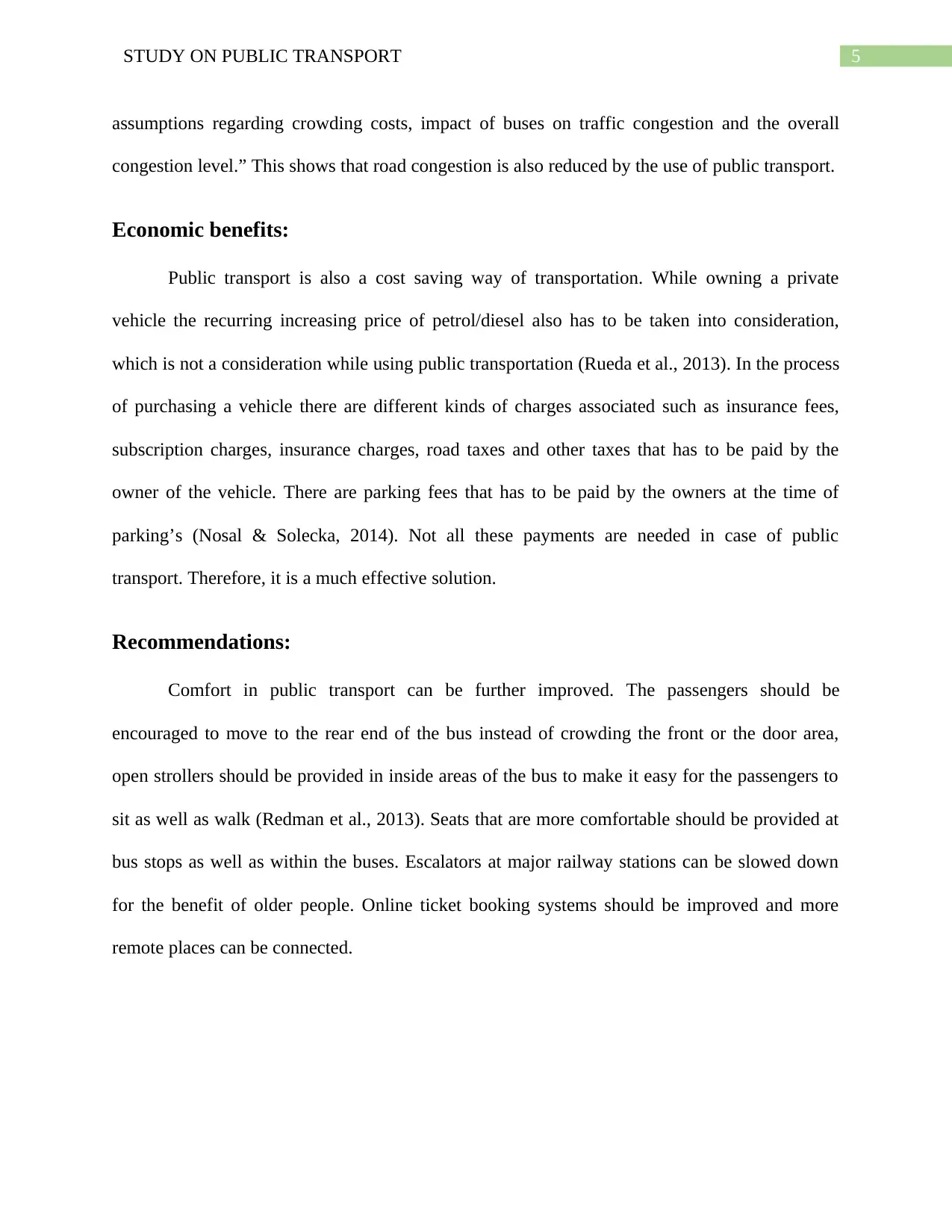
5STUDY ON PUBLIC TRANSPORT
assumptions regarding crowding costs, impact of buses on traffic congestion and the overall
congestion level.” This shows that road congestion is also reduced by the use of public transport.
Economic benefits:
Public transport is also a cost saving way of transportation. While owning a private
vehicle the recurring increasing price of petrol/diesel also has to be taken into consideration,
which is not a consideration while using public transportation (Rueda et al., 2013). In the process
of purchasing a vehicle there are different kinds of charges associated such as insurance fees,
subscription charges, insurance charges, road taxes and other taxes that has to be paid by the
owner of the vehicle. There are parking fees that has to be paid by the owners at the time of
parking’s (Nosal & Solecka, 2014). Not all these payments are needed in case of public
transport. Therefore, it is a much effective solution.
Recommendations:
Comfort in public transport can be further improved. The passengers should be
encouraged to move to the rear end of the bus instead of crowding the front or the door area,
open strollers should be provided in inside areas of the bus to make it easy for the passengers to
sit as well as walk (Redman et al., 2013). Seats that are more comfortable should be provided at
bus stops as well as within the buses. Escalators at major railway stations can be slowed down
for the benefit of older people. Online ticket booking systems should be improved and more
remote places can be connected.
assumptions regarding crowding costs, impact of buses on traffic congestion and the overall
congestion level.” This shows that road congestion is also reduced by the use of public transport.
Economic benefits:
Public transport is also a cost saving way of transportation. While owning a private
vehicle the recurring increasing price of petrol/diesel also has to be taken into consideration,
which is not a consideration while using public transportation (Rueda et al., 2013). In the process
of purchasing a vehicle there are different kinds of charges associated such as insurance fees,
subscription charges, insurance charges, road taxes and other taxes that has to be paid by the
owner of the vehicle. There are parking fees that has to be paid by the owners at the time of
parking’s (Nosal & Solecka, 2014). Not all these payments are needed in case of public
transport. Therefore, it is a much effective solution.
Recommendations:
Comfort in public transport can be further improved. The passengers should be
encouraged to move to the rear end of the bus instead of crowding the front or the door area,
open strollers should be provided in inside areas of the bus to make it easy for the passengers to
sit as well as walk (Redman et al., 2013). Seats that are more comfortable should be provided at
bus stops as well as within the buses. Escalators at major railway stations can be slowed down
for the benefit of older people. Online ticket booking systems should be improved and more
remote places can be connected.
⊘ This is a preview!⊘
Do you want full access?
Subscribe today to unlock all pages.

Trusted by 1+ million students worldwide
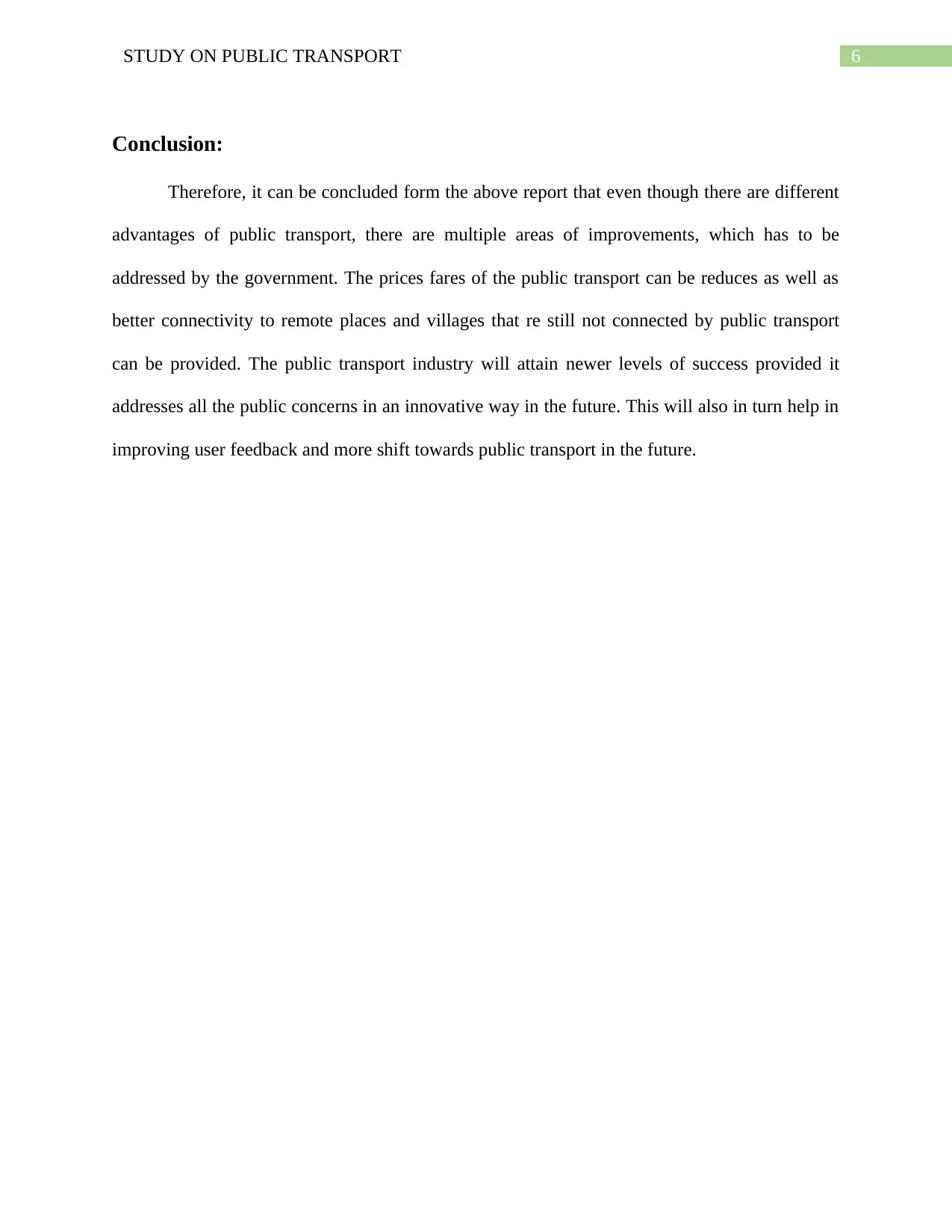
6STUDY ON PUBLIC TRANSPORT
Conclusion:
Therefore, it can be concluded form the above report that even though there are different
advantages of public transport, there are multiple areas of improvements, which has to be
addressed by the government. The prices fares of the public transport can be reduces as well as
better connectivity to remote places and villages that re still not connected by public transport
can be provided. The public transport industry will attain newer levels of success provided it
addresses all the public concerns in an innovative way in the future. This will also in turn help in
improving user feedback and more shift towards public transport in the future.
Conclusion:
Therefore, it can be concluded form the above report that even though there are different
advantages of public transport, there are multiple areas of improvements, which has to be
addressed by the government. The prices fares of the public transport can be reduces as well as
better connectivity to remote places and villages that re still not connected by public transport
can be provided. The public transport industry will attain newer levels of success provided it
addresses all the public concerns in an innovative way in the future. This will also in turn help in
improving user feedback and more shift towards public transport in the future.
Paraphrase This Document
Need a fresh take? Get an instant paraphrase of this document with our AI Paraphraser
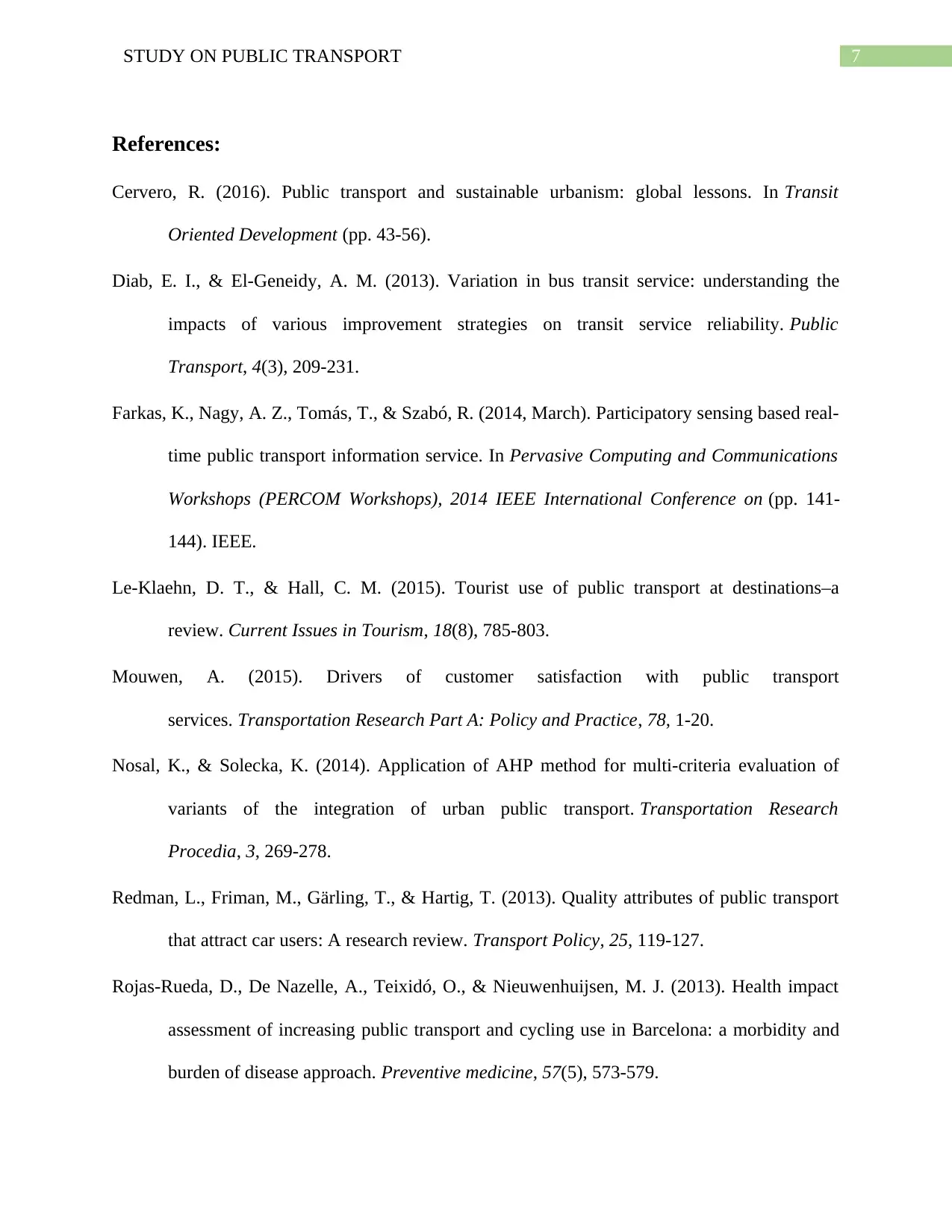
7STUDY ON PUBLIC TRANSPORT
References:
Cervero, R. (2016). Public transport and sustainable urbanism: global lessons. In Transit
Oriented Development (pp. 43-56).
Diab, E. I., & El-Geneidy, A. M. (2013). Variation in bus transit service: understanding the
impacts of various improvement strategies on transit service reliability. Public
Transport, 4(3), 209-231.
Farkas, K., Nagy, A. Z., Tomás, T., & Szabó, R. (2014, March). Participatory sensing based real-
time public transport information service. In Pervasive Computing and Communications
Workshops (PERCOM Workshops), 2014 IEEE International Conference on (pp. 141-
144). IEEE.
Le-Klaehn, D. T., & Hall, C. M. (2015). Tourist use of public transport at destinations–a
review. Current Issues in Tourism, 18(8), 785-803.
Mouwen, A. (2015). Drivers of customer satisfaction with public transport
services. Transportation Research Part A: Policy and Practice, 78, 1-20.
Nosal, K., & Solecka, K. (2014). Application of AHP method for multi-criteria evaluation of
variants of the integration of urban public transport. Transportation Research
Procedia, 3, 269-278.
Redman, L., Friman, M., Gärling, T., & Hartig, T. (2013). Quality attributes of public transport
that attract car users: A research review. Transport Policy, 25, 119-127.
Rojas-Rueda, D., De Nazelle, A., Teixidó, O., & Nieuwenhuijsen, M. J. (2013). Health impact
assessment of increasing public transport and cycling use in Barcelona: a morbidity and
burden of disease approach. Preventive medicine, 57(5), 573-579.
References:
Cervero, R. (2016). Public transport and sustainable urbanism: global lessons. In Transit
Oriented Development (pp. 43-56).
Diab, E. I., & El-Geneidy, A. M. (2013). Variation in bus transit service: understanding the
impacts of various improvement strategies on transit service reliability. Public
Transport, 4(3), 209-231.
Farkas, K., Nagy, A. Z., Tomás, T., & Szabó, R. (2014, March). Participatory sensing based real-
time public transport information service. In Pervasive Computing and Communications
Workshops (PERCOM Workshops), 2014 IEEE International Conference on (pp. 141-
144). IEEE.
Le-Klaehn, D. T., & Hall, C. M. (2015). Tourist use of public transport at destinations–a
review. Current Issues in Tourism, 18(8), 785-803.
Mouwen, A. (2015). Drivers of customer satisfaction with public transport
services. Transportation Research Part A: Policy and Practice, 78, 1-20.
Nosal, K., & Solecka, K. (2014). Application of AHP method for multi-criteria evaluation of
variants of the integration of urban public transport. Transportation Research
Procedia, 3, 269-278.
Redman, L., Friman, M., Gärling, T., & Hartig, T. (2013). Quality attributes of public transport
that attract car users: A research review. Transport Policy, 25, 119-127.
Rojas-Rueda, D., De Nazelle, A., Teixidó, O., & Nieuwenhuijsen, M. J. (2013). Health impact
assessment of increasing public transport and cycling use in Barcelona: a morbidity and
burden of disease approach. Preventive medicine, 57(5), 573-579.
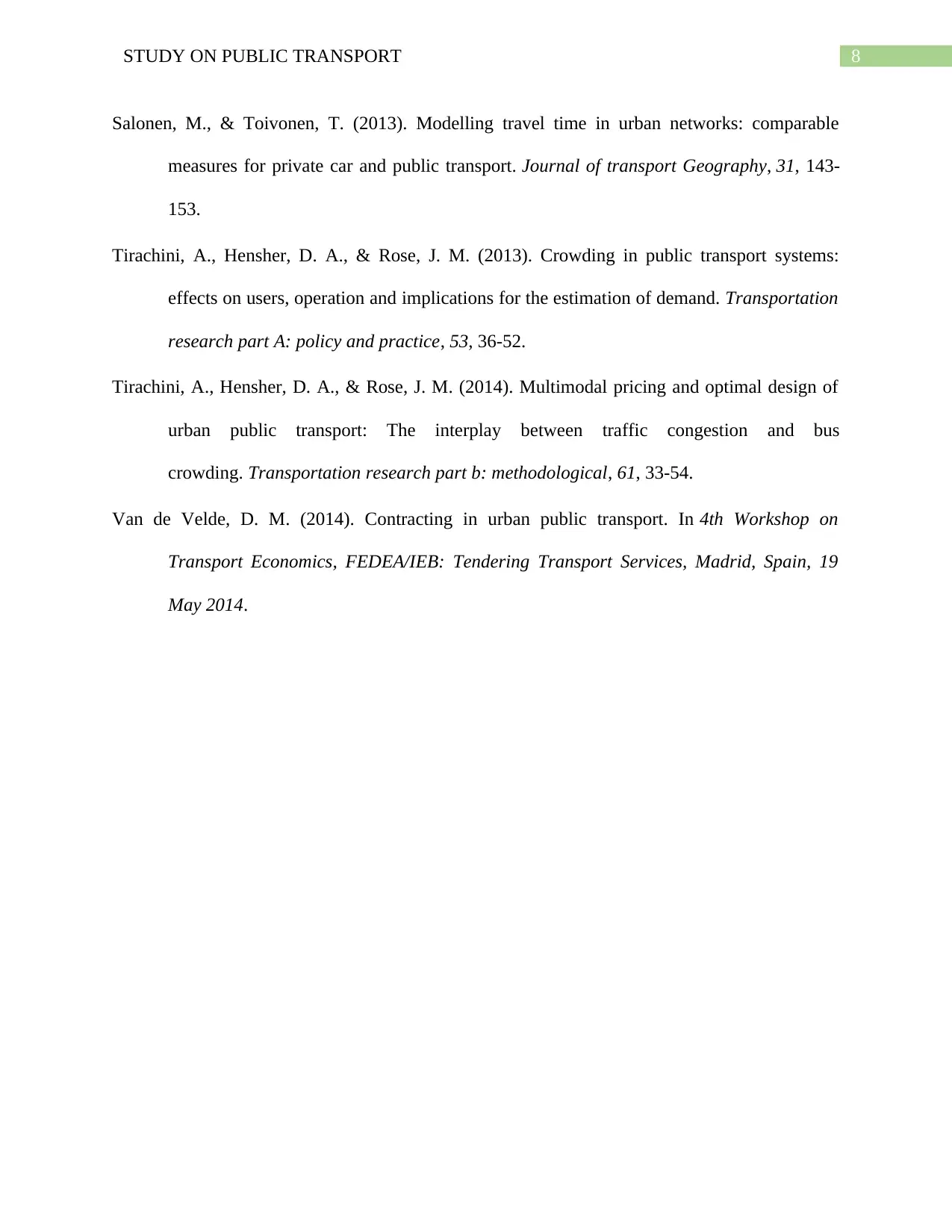
8STUDY ON PUBLIC TRANSPORT
Salonen, M., & Toivonen, T. (2013). Modelling travel time in urban networks: comparable
measures for private car and public transport. Journal of transport Geography, 31, 143-
153.
Tirachini, A., Hensher, D. A., & Rose, J. M. (2013). Crowding in public transport systems:
effects on users, operation and implications for the estimation of demand. Transportation
research part A: policy and practice, 53, 36-52.
Tirachini, A., Hensher, D. A., & Rose, J. M. (2014). Multimodal pricing and optimal design of
urban public transport: The interplay between traffic congestion and bus
crowding. Transportation research part b: methodological, 61, 33-54.
Van de Velde, D. M. (2014). Contracting in urban public transport. In 4th Workshop on
Transport Economics, FEDEA/IEB: Tendering Transport Services, Madrid, Spain, 19
May 2014.
Salonen, M., & Toivonen, T. (2013). Modelling travel time in urban networks: comparable
measures for private car and public transport. Journal of transport Geography, 31, 143-
153.
Tirachini, A., Hensher, D. A., & Rose, J. M. (2013). Crowding in public transport systems:
effects on users, operation and implications for the estimation of demand. Transportation
research part A: policy and practice, 53, 36-52.
Tirachini, A., Hensher, D. A., & Rose, J. M. (2014). Multimodal pricing and optimal design of
urban public transport: The interplay between traffic congestion and bus
crowding. Transportation research part b: methodological, 61, 33-54.
Van de Velde, D. M. (2014). Contracting in urban public transport. In 4th Workshop on
Transport Economics, FEDEA/IEB: Tendering Transport Services, Madrid, Spain, 19
May 2014.
⊘ This is a preview!⊘
Do you want full access?
Subscribe today to unlock all pages.

Trusted by 1+ million students worldwide
1 out of 9
Related Documents
Your All-in-One AI-Powered Toolkit for Academic Success.
+13062052269
info@desklib.com
Available 24*7 on WhatsApp / Email
![[object Object]](/_next/static/media/star-bottom.7253800d.svg)
Unlock your academic potential
Copyright © 2020–2025 A2Z Services. All Rights Reserved. Developed and managed by ZUCOL.




